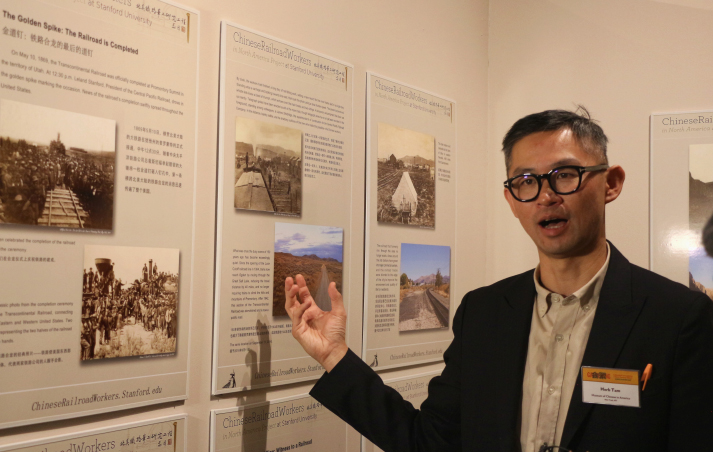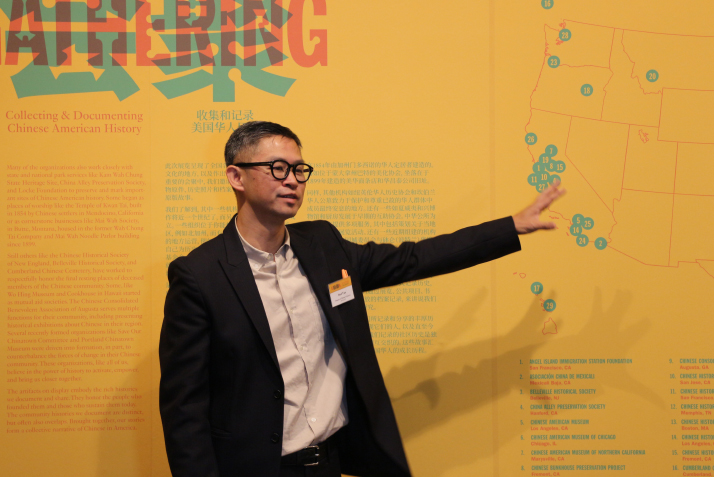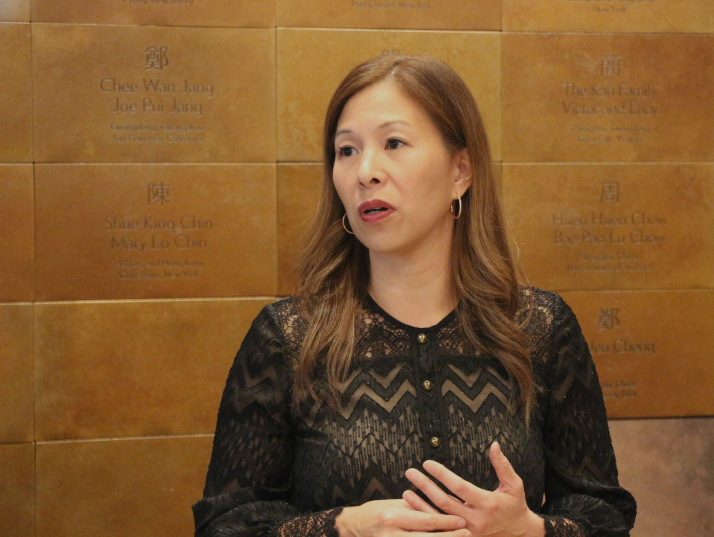| Lifestyle |
| Untold Stories Brought to Life | |
| U.S. museum celebrates contributions of forgotten Chinese railroad workers | |
|
|
 Herb Tam, Curator and Director of Exhibitions of MOCA, tells the story of Chinese laborers who were instrumental in building the First Transcontinental Railroad in New York City on October 16 (ZHAO WEI)
While 2019 marks the 150th anniversary of a major milestone in U.S. history, the completion of the First Transcontinental Railroad, an over 3,000-km rail link connecting the East Coast with the West Coast, its major workforce of about 12,000 Chinese immigrants remained long forgotten, and their contributions and sacrifices little recognized. But last month, the Museum of Chinese in America (MOCA) in New York City brought to light the untold stories in the making of the United States through the lens of the Chinese immigrant experience and redefined the American narrative with two comprehensive exhibitions. Collecting and Documenting Chinese American History and The Chinese Helped Build the Railroad–The Railroad Helped Build America opened in MOCA on October 17 and will run till March 22, 2020. MOCA brought together descendants of the railroad workers and representatives of history societies that document the history of the Chinese to show a collective image of often neglected and discriminated-against Chinese immigrants. "We are urgently presenting these stories; and we are eager and anxious about [them] not only because we are fraught with tensions in the bilateral relationship, [but because] we are fraught with the attention of Asian-Americans and our roles in this country," MOCA President Nancy Yao Maasbach said. Putting the U.S. on track On May 10, 1869, leaders of the Central Pacific and Union Pacific Railroads, the two rail companies entrusted with building the First Transcontinental Railroad, gathered in Utah to celebrate its completion. Yet the major workforce, over 12,000 Chinese laborers, was invisible at the ceremony and remained missing in the history-telling for over a century. In a 1927 article in The Southern Pacific Bulletin, Erle Heath, then associate editor of the publication, wrote how the Chinese workers, who were nicknamed iron workers, laid over 16 km of tracks in 12 hours back in 1869. However, none of their names were known. They were all remembered as "John Chinaman." "After 200 years [of] being a fundamental part of the fabric of this country, tell me one hero you know of Chinese ancestry," Maasbach said. "We have a legacy here that is unfortunate. It is discrimination and racism, we are fighting that every day." The Chinese Helped Build the Railroad–The Railroad Helped Build America presents the collective journey of the Chinese laborers through historical and contemporary photographs of the sites along the route by photographer Li Ju. Now institutions, historical organizations and museums have joined forces to give voice to the long-neglected Chinese immigrants. Twenty-eight historical societies, museums and projects from 13 U.S. states ranging from the East Coast to the Hawaiian Islands shared their studies and memories of early Chinese immigrants through historical objects. "These organizations were founded as public history spaces to highlight and celebrate the under-recognized contributions of Chinese people to American history and culture," Herb Tam, Curator and Director of Exhibitions at MOCA, said. Stanford University initiated the Chinese Railroad Workers in North America Project to educate the next generation on this pivotal but long-forgotten history. Stanford designed an interactive website and four lessons for high school audiences to learn both about Chinese railroad workers and Chinese culture.  Herb Tam, Curator and Director of Exhibitions of MOCA, introduces the exhibition on October 17 in New York (ZHAO WEI)
U.S. town, Chinese history Michael Perrone, President of the Belleville Historical Society in New Jersey, recalled their efforts to preserve the history of Chinese immigrants in Belleville, a city known for its campaign against slavery. "We always think New York City is the first Chinese immigrant settlement in the eastern United States, but actually the first Chinese community was established in Belleville in 1870," Perrone told Beijing Review. Belleville, home of the country's largest commercial laundry at the time, was eager to employ a more stable labor force. A retired sea captain James Hervey hired the Chinese laborers, who came to the East Coast for job opportunities after completing the railroad, for his Passaic Steam Laundry, according to a study by the Belleville Historical Society. The first 68 Chinese workers arrived in 1870 and expanded their population in the next 15 years. "The first Chinese New Year was celebrated here in January 1871, the first school for the Chinese opened here in September 1871, the first Chinese immigrant was buried here," Perrone said. In 2016, Perrone and his colleagues built a red brick monument topped with a white pagoda roof in remembrance of the Chinese immigrants in Belleville. The day following the completion of the monument, they saw something sticking out in the immigrants' cemetery. It turned out to be a seaming iron, the kind a laundry worker would use. "For 20 years, we cleaned that cemetery and probed every square, but did not find a thing. This particular iron may or may not be from a Chinese immigrant, but the message was from the Chinese workers," Perrone said. "Now we are preparing for next year, which is the 150th anniversary of the Chinese coming to Belleville. We are working on constructing a dragon boat and have many activities planned," he added.  Nancy Yao Maasbach, President of the Museum of Chinese in America, addresses the opening of the exhibitions in New York City on October 16 (ZHAO WEI)
The Chinese legacy Gerry Low-Sabado, a fifth-generation descendant whose ancestors came from a Chinese fishing village and then worked on the railroad, shared her family's story back to the 1850s. The 69-year-old said her ancestors sailed across the Pacific from China to California in an engineless boat in the 1850s and her great-grandfather Quock Tuck Lee helped build the rail line to Monterey and Pacific Grove. As a community preservationist in Fremont, California, Low-Sabado has initiated the Walk of Remembrance to tell the story of the early pioneering Chinese-American fishing village that existed in Pacific Grove from 1854 to 1907. The 2019 Walk of Remembrance on May 4 marked the 10th walk to honor the Chinese immigrants. On the 150th anniversary of the completion of the last section of the railroad between Sacramento and Oakland in California, Low-Sabado attended the "true completion of the transcontinental ceremony." "I was trying to reclaim my ancestors' real Chinese-American history and bring about a change in the play by bringing respect to the Chinese, what I call 'change with kindness,'" she said. "With my generation, because of the Chinese Exclusion Act, my parents did not teach us Chinese. But we still carried on the traditions, like the Qingming Festival," she said. The 1882 Chinese Exclusion Act, prohibiting the immigration of Chinese laborers, was the earliest anti-immigration measure targeting a specific community and was made permanent in 1902. The Qingming Festival, also known as Tomb-Sweeping Day, is a traditional Chinese festival when families remember and pay tributes to their ancestors. Low-Sabado showed up at the MOCA exhibition in a red traditional Chinese jacket with a straw bucket hat in hand, part of her family's fishing heritage. "On special occasions, I encourage my kids to come to the events to represent the next generation [of Chinese immigrants," she said. (Reporting from New York City) Copyedited by Sudeshna Sarkar Comments to dingying@bjreview.com |
|
||||||||||||||||||||||||||||||
|